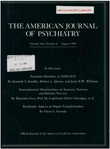Biogenic amine and metabolite levels in depressed patients with high versus normal hypothalamic-pituitary-adrenocortical activity
Abstract
The activity of the hypothalamic-pituitary-adrenocortical (HPA) axis is often high in depressive illness. The authors studied 132 depressed patients and 80 healthy control subjects. They report a significant direct association between HPA axis activity and adrenomedullary epinephrine secretion in depressed patients. They also found that depressed patients with high HPA activity tend to have lower CSF levels of 5-hydroxyindoleacetic acid, a serotonin metabolite, and modestly lower levels of 3-methoxy-4-hydroxyphenylglycol, a metabolite of epinephrine and norepinephrine, than patients with normal HPA activity. These findings provide potentially important leads for understanding interactions of biogenic amine systems with HPA axis function.
Access content
To read the fulltext, please use one of the options below to sign in or purchase access.- Personal login
- Institutional Login
- Sign in via OpenAthens
- Register for access
-
Please login/register if you wish to pair your device and check access availability.
Not a subscriber?
PsychiatryOnline subscription options offer access to the DSM-5 library, books, journals, CME, and patient resources. This all-in-one virtual library provides psychiatrists and mental health professionals with key resources for diagnosis, treatment, research, and professional development.
Need more help? PsychiatryOnline Customer Service may be reached by emailing [email protected] or by calling 800-368-5777 (in the U.S.) or 703-907-7322 (outside the U.S.).



